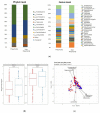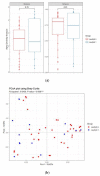The Dynamics of Respiratory Microbiota during Mechanical Ventilation in Patients with Pneumonia
- PMID: 32120914
- PMCID: PMC7141134
- DOI: 10.3390/jcm9030638
The Dynamics of Respiratory Microbiota during Mechanical Ventilation in Patients with Pneumonia
Abstract
Bacterial pneumonia is a major cause of mechanical ventilation in intensive care units. We hypothesized that the presence of particular microbiota in endotracheal tube aspirates during the course of intubation was associated with clinical outcomes such as extubation failure or 28-day mortality. Sixty mechanically ventilated ICU (intensive care unit) patients (41 patients with pneumonia and 19 patients without pneumonia) were included, and tracheal aspirates were obtained on days 1, 3, and 7. Gene sequencing of 16S rRNA was used to measure the composition of the respiratory microbiome. A total of 216 endotracheal aspirates were obtained from 60 patients. A total of 22 patients were successfully extubatedwithin3 weeks, and 12 patients died within 28days. Microbiota profiles differed significantly between the pneumonia group and the non-pneumonia group (Adonis, p < 0.01). While α diversity (Shannon index) significantly decreased between day 1 and day 7 in the successful extubation group, it did not decrease in the failed extubation group among intubated patients with pneumonia. There was a significant difference in the change of βdiversity between the successful extubation group and the failed extubation group for Bray-Curtis distances (p < 0.001). At the genus level, Rothia, Streptococcus, and Prevotella correlated with the change of β diversity. A low relative abundance of Streptococci at the time of intubation was strongly associated with 28-day mortality. The dynamics of respiratory microbiome were associated with clinical outcomes such as extubation failure and mortality. Further large prospective studies are needed to test the predictive value of endotracheal aspirates in intubated patients.
Keywords: mechanical ventilation; microbiome; pneumonia.
Conflict of interest statement
The authors declare that they have no conflicts of interests.
Figures









References
-
- Xu J., Murphy S.L., Kochanek K.D., Bastian B., Arias E. Deaths: Final data for 2016. Natl. Vital Stat. Rep. 2018;67:1–76. - PubMed
-
- Kalil A.C., Metersky M.L., Klompas M., Muscedere J., Sweeney D.A., Palmer L.B., El Solh A.A. Executive Summary: Management of Adults with Hospital-acquired and Ventilator-associated Pneumonia: 2016 Clinical Practice Guidelines by the Infectious Diseases Society of America and the American Thoracic Society. Clin. Infect. Dis. 2016;63:575–582. doi: 10.1093/cid/ciw504. - DOI - PMC - PubMed
-
- Esperatti M., Ferrer M., Theessen A., Liapikou A., Valencia M., Saucedo L.M., Torres A. Nosocomial pneumonia in the intensive care unit acquired by mechanically ventilated versus nonventilated patients. Am. J. Respir. Crit. Care Med. 2010;182:1533–1539. doi: 10.1164/rccm.201001-0094OC. - DOI - PubMed
Grants and funding
LinkOut - more resources
Full Text Sources

